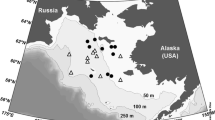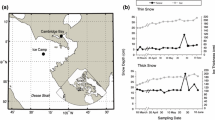Abstract
Various abiotic and biotic parameters, including phytoplankton distribution, were studied to investigate seasonal changes within the fast-ice cover in Chupa Inlet, a freshwater-influenced Arctic-like fjord in Kandalaksha Bay (White Sea). Sea ice and under-ice water were collected along transects in the inlet in February and April 2002. Ice-texture analysis, salinity and δ18O values indicated that the complete ice sheet had transformed within 2 months. This resulted from an upward growth of snow ice and subsequent melting at the underside of the ice, which makes a comparison between the two sampling periods difficult in terms of defining temporal developments within the ice. Nutrients, DOC and DON concentrations in the under-ice water were typical for Russian Arctic rivers. Concentrations of nitrate, silicate and DOC in the ice were lower, which is attributed to a loss as the ice forms. The concentrations were also modified by biological activity. In February, there was a strong correspondence between the distribution of biological parameters, including particulate and dissolved organic carbon and nitrogen (POC and PON, DOC and DON) and inorganic nutrients (nitrate, nitrite, phosphate and silicate), which was not the case in April. The correlation between both DOC and DON with ammonium indicates heterotrophic activity within the winter ice collected in February. Sea-ice organisms were distributed throughout the ice, and several assemblages were found in surface layers of the ice. In April, a more "typical" distribution of biomass in the ice was measured, with low values in the upper part and high algal concentrations in the lower sections of the ice, characteristic of a spring ice-algal bloom. In contrast to the February sampling, there was evidence that the ice-algal assemblage in April was nitrogen-limited, with total inorganic nitrogen concentrations being <1 µm and a mean inorganic nitrogen to phosphorus ratio of 2.8. The ice assemblages were dominated by diatoms (in particular, Nitzschia spp.). There were temporal shifts in the assemblage composition: in February, diatoms accounted for 40% and in April for >98% of all organisms counted.








Similar content being viewed by others
References
Arrigo KR (2003) Primary production in sea ice. In: Thomas DN, Dieckmann GS (eds) Sea ice—an introduction to its physics, chemistry, biology and geology. Blackwell, Oxford, pp 143–183
Berger V, Dahle S, Galaktionov K, Kosobokova X, Naumov A, Rat'kova T, Savinov VM, Savinova TN (eds) (2001) White Sea ecology and environment. Derzavets, St. Petersburg
Cota GF, Prinsenberg SJ, Bennett EB, Loder JW, Lewis MR, Anning JL, Watson NHF, Harris LR (1987) Nutrient fluxes during extended blooms of Arctic ice algae. J Geophys Res C 92:1951–1962
Cox GFN, Weeks WF (1983) Equations for determining the gas and brine volumes in sea-ice samples. J Glaciol 29:306–316
Dittmar T, Kattner G (2003) The biogeochemistry of the river and shelf ecosystem of the Arctic Ocean: a review. Mar Chem (in press)
Evans CA, O'Reilly JE, Thomas JP (1987) A handbook for the measurement of chlorophyll a and primary production. Biological investigations of marine Antarctic systems and stocks (BIOMASS). Texas A&M University, College Station, Texas
Garrison DL, Buck KR (1986) Organism losses during ice melting: a serious bias in sea ice community studies. Polar Biol 6:237–239
Gradinger R, Friedrich C, Spindler M (1999) Abundance, biomass and composition of the sea ice biota of the Greenland Sea pack ice. Deep Sea Res II 46:1457–1472
Grant WS, Horner RA (1976) Growth responses to salinity variation in four Arctic ice diatoms. J Phycol 12:180–185
Haas C, Thomas DN, Bareiss J (2001) Surface properties and processes of perennial Antarctic sea ice in summer. J Glaciol 47:613–625
Haecky P, Andersson A (1999) Primary and bacterial production in sea ice in the northern Baltic Sea. Aquat Microb Ecol 20:107–118
Haecky P, Jonsson S, Andersson A (1998) Influence of sea ice on the composition of the spring phytoplankton bloom in the northern Baltic Sea. Polar Biol 20:1–8
Hasle GR (1978) The inverted-microscope method. In: Sournia A (ed) Phytoplankton manual. UNESCO Monogr Oceanogr Methodol 6:88–96
Howland RJM, Pantiulin AN, Millward GE, Prego R (1999) The hydrography of the Chupa Estuary, White Sea, Russia. Estuarine Coast Shelf Sci 48:1–12
Kaartokallio H (2001) Evidence for active microbial nitrogen transformations in sea ice (Gulf of Bothnia, Baltic Sea) in midwinter. Polar Biol 24:21–28
Kalnay E, Kanamitsu M, Kistler R, Collins W, Deaven D, Gandin L, Iredell M, Saha S, White G, Woollen J, Zhu Y, Chelliah M, Ebisuzaki W, Higgins W, Janowiak J, Mo KC, Ropelewski C, Wang J, Leetmaa A, Reynolds R, Jenne R, Joseph D (1996) The NCEP/NCAR 40-year reanalysis project. Bull Am Meteorol Soc 77:437–471
Kattner G (1999) Storage of dissolved inorganic nutrients in seawater: poisoning with mercuric chloride. Mar Chem 67:61–66
Kattner G, Becker H (1991) Nutrients and organic nitrogenous compounds in the marginal ice zone of the Fram Strait. J Mar Syst 2:385–394
Kawamura T, Shirasawa K, Ishikawa N, Lindfors A, Rasmus K, Granskog MA, Ehn J, Leppäranta M, Martma T, Vaikmäe R (2001) Time-series observations of the structure and properties of brackish ice in the Gulf of Finland. Ann Glaciol 33:1–4
Lange MA (1988) Basic properties of Antarctic sea ice as revealed by textural analysis of ice cores. Ann Glaciol 10:95–101
Lara R, Thomas D (1995) Formation of recalcitrant organic matter: humification dynamics of algal derived dissolved organic carbon and its hydrophobic fractions. Mar Chem 51:193–199
Legendre L, Robineau B, Gosselin M, Michel C, Ingram RG, Fortier L, Therriault JC, Demers S, Monti D (1996) Impact of freshwater on a subarctic coastal ecosystem under seasonal sea ice (southeastern Hudson Bay, Canada). II. Production and export of microalgae. J Mar Syst 7:233–250
Leppäranta M, Tikkanen M, Shemeikka P (1998) Observations of ice and its sediments on the Baltic Sea coast. Nord Hydrol 29:199–220
Lizotte MP (2003) The microbiology of sea ice. In: Thomas DN, Dieckmann GS (eds) Sea ice—an introduction to its physics, chemistry, biology and geology. Blackwell, Oxford, pp 184–210
Lobbes JM, Fitznar HP, Kattner G (2000) Biogeochemical characteristics of dissolved and particulate organic matter in Russian rivers entering the Arctic Ocean. Geochim Cosmochim Acta 64:2973–2983
Lytle VI, Ackley SF (2001) Snow-ice growth: a fresh-water flux inhibiting deep convection in the Weddell Sea, Antarctica. Ann Glaciol 33:45–50
Mackensen A (2001) Oxygen and carbon stable isotope tracers of Weddell Sea water masses: new data and some paleoceanographic implications. Deep Sea Res I 48:1401–1422
Meiners K, Fehling J, Granskog MA, Spindler M (2002) Abundance, biomass and composition of biota in Baltic sea ice and underlying water (March 2000). Polar Biol 25:761–770
Mock T, Gradinger R (1999) Determination of Arctic ice algal production with a new in situ incubation technique. Mar Ecol Prog Ser 177:15–26
Mordasova NV (1999) Chlorophyll in the White Sea. ICES J Mar Sci 56:215–218
Pautova L, Vinogradov G (2001) Southeastern Barents Sea plankton in April 2000. Russian Academy of Sciences. Oceanology 41:211–217
Pomeroy LR, Wiebe WJ (2001) Temperature and substrates as interactive limiting factors for marine heterotrophic bacteria. Aquat Microb Ecol 23:187–204
Qian J, Mopper K (1996) Automated high-performance, high-temperature combustion total carbon analyzer. Anal Chem 68:3090–3097
Rahm L, Hakansson B, Larsson P, Fogelqvist E, Bremle G, Valderama J (1995) Nutrient and persistent pollutant deposition on the Bothnia Bay ice and snow fields. Water Air Soil Pollut 84:187–201
Shanin SS, Mikhajlovskij GE (1996) Species diversity and seasonal succession of phytoplankton in the White Sea. Oceanology 36:407–412
Syvertsen EE (1991) Ice algae in the Barents Sea: types of assemblages, origin, fate and role in the ice-edge phytoplankton bloom. Polar Res 10:277–288
Thomas DN, Dieckmann GS (2002) Biogeochemistry of antarctic sea ice. Oceanogr Mar Biol Annu Rev 40:143–169
Thomas DN, Lara R, Eicken H, Kattner G, Skoog A (1995) Dissolved organic matter in Arctic multi-year ice during winter: major components and relationships to ice characteristics. Polar Biol 15:477–483
Thomas DN, Kattner G, Engbrodt R, Giannelli V, Kennedy H, Haas C, Dieckmann GS (2001) Dissolved organic matter in Antarctic sea ice. Ann Glaciol 33:297–303
Venrick EL (1978) How many cells to count? In: Sournia A (ed) Phytoplankton manual. UNESCO Monogr Oceanogr Methodol 6:167–196
Weissenberger J, Dieckmann G, Gradinger R, Spindler M (1992) Sea ice: a cast technique to examine and analyze brine pockets and channel structure. Limnol Oceanogr 37:179–183
Weslawski JM, Wiktor J, Koszteyn J, Zajaczkowski M, Wieczorek P, Kotwicki L (1997) The coastal edge of the Northeast Water polynya in spring 1993. J Mar Syst 10:429–444
Wiktor J (1999) Early spring microplankton development under fast ice covered fjords of Svalbard, Arctic. Oceanologia 41:51–72
Zhitina LS, Mikhajlovskij GE (1990) Ice and plankton flora of the White Sea as the subject of monitoring. Biological monitoring of the White Sea coastal waters. IOAN, Moscow (in Russian)
Acknowledgements
The authors are grateful to the staff of Kartesh Biological Station for their co-operation and assistance throughout the two field trips. Andreas Mackensen is thanked for his assistance in the oxygen isotope analyses. We thank Erika Allhusen and Marthi Wolff for excellent technical support and Zuzana Krell-Laluhová, Matthias Steffens and Oleg Fajans for their help during the fieldwork. This work was supported by EU funding through the Copernicus Programme, research project WOMP (ICA2-CT-2000-1003). D.N.T. is also grateful for the support of the Hanse Institute of Advanced Study and the Royal Society (Joint Project).
Author information
Authors and Affiliations
Corresponding author
Rights and permissions
About this article
Cite this article
Krell, A., Ummenhofer, C., Kattner, G. et al. The biology and chemistry of land fast ice in the White Sea, Russia—A comparison of winter and spring conditions. Polar Biol 26, 707–719 (2003). https://doi.org/10.1007/s00300-003-0543-7
Received:
Accepted:
Published:
Issue Date:
DOI: https://doi.org/10.1007/s00300-003-0543-7




